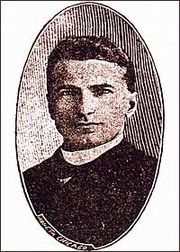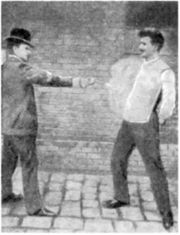
Casimir Zeglen
Encyclopedia

Ternopil
Ternopil , is a city in western Ukraine, located on the banks of the Seret River. Ternopil is one of the major cities of Western Ukraine and the historical region of Galicia...
(today Ternopil, Ukraine), invented the first bulletproof vest. At the age of 18 he entered the Resurrectionist Order
Resurrectionist Order
The Congregation of the Resurrection of Our Lord Jesus Christ is an international Institute of Consecrated Life of men within the Roman Catholic Church, founded in 1836 by three men, Bogdan Jański, Peter Semenenko and Hieronim Kajsiewicz in Paris on the heels of the Polish Great Emigration...
in Lwow
Lviv
Lviv is a city in western Ukraine. The city is regarded as one of the main cultural centres of today's Ukraine and historically has also been a major Polish and Jewish cultural center, as Poles and Jews were the two main ethnicities of the city until the outbreak of World War II and the following...
(today Lviv, Ukraine). In 1890, he moved to the United States
United States
The United States of America is a federal constitutional republic comprising fifty states and a federal district...
. In 1893, after the assassination of Carter Harrison, Sr.
Carter Harrison, Sr.
Carter Henry Harrison, Sr. was an American politician who served as mayor of Chicago, Illinois from 1879 until 1887; he was subsequently elected to a fifth term in 1893 but was assassinated before completing his term. He previously served two terms in the United States House of Representatives...
, the mayor of Chicago
Mayor of Chicago
The Mayor of Chicago is the chief executive of Chicago, Illinois, the third largest city in the United States. He or she is charged with directing city departments and agencies, and with the advice and consent of the Chicago City Council, appoints department and agency leaders.-Appointment...
, he invented the first bulletproof vest. In 1897, he improved it together with Jan Szczepanik
Jan Szczepanik
Jan Szczepanik was a Polish inventor....
who was the inventor of the first bulletproof armour in 1901. It saved the life Alfonso XIII
Alfonso XIII of Spain
Alfonso XIII was King of Spain from 1886 until 1931. His mother, Maria Christina of Austria, was appointed regent during his minority...
, the King of Spain - his carriage was covered with Szczepanik's bulletproof armour when a bomb exploded near it.
He was a Catholic priest
Priesthood (Catholic Church)
The ministerial orders of the Catholic Church include the orders of bishops, deacons and presbyters, which in Latin is sacerdos. The ordained priesthood and common priesthood are different in function and essence....
of St. Stanislaus Kostka Roman Catholic Church
Roman Catholic Church
The Catholic Church, also known as the Roman Catholic Church, is the world's largest Christian church, with over a billion members. Led by the Pope, it defines its mission as spreading the gospel of Jesus Christ, administering the sacraments and exercising charity...
in Chicago
Chicago
Chicago is the largest city in the US state of Illinois. With nearly 2.7 million residents, it is the most populous city in the Midwestern United States and the third most populous in the US, after New York City and Los Angeles...
, then the largest Polish
Poland
Poland , officially the Republic of Poland , is a country in Central Europe bordered by Germany to the west; the Czech Republic and Slovakia to the south; Ukraine, Belarus and Lithuania to the east; and the Baltic Sea and Kaliningrad Oblast, a Russian exclave, to the north...
church in the country, with 40,000 in the parish. In his early 20s he began experimenting with the cloth, using steel shavings, moss
Moss
Mosses are small, soft plants that are typically 1–10 cm tall, though some species are much larger. They commonly grow close together in clumps or mats in damp or shady locations. They do not have flowers or seeds, and their simple leaves cover the thin wiry stems...
, hair
Hair
Hair is a filamentous biomaterial, that grows from follicles found in the dermis. Found exclusively in mammals, hair is one of the defining characteristics of the mammalian class....
, etc. but nothing stood the test until he made use of silk
Silk
Silk is a natural protein fiber, some forms of which can be woven into textiles. The best-known type of silk is obtained from the cocoons of the larvae of the mulberry silkworm Bombyx mori reared in captivity...
. All early experiments produced an inflexible cloth which was more in the nature of a coat of chainmail
Mail (armour)
Mail is a type of armour consisting of small metal rings linked together in a pattern to form a mesh.-History:Mail was a highly successful type of armour and was used by nearly every metalworking culture....
. After the assassination of Mayor Carter Harrison, Zeglen renewed his efforts to find a bulletproof material and determined to use silk. In his mid 30s he discovered a way to weave the silk, to enable it to capture the bullet, while visiting weaving mills in Vienna
Vienna
Vienna is the capital and largest city of the Republic of Austria and one of the nine states of Austria. Vienna is Austria's primary city, with a population of about 1.723 million , and is by far the largest city in Austria, as well as its cultural, economic, and political centre...
, Austria
Austria
Austria , officially the Republic of Austria , is a landlocked country of roughly 8.4 million people in Central Europe. It is bordered by the Czech Republic and Germany to the north, Slovakia and Hungary to the east, Slovenia and Italy to the south, and Switzerland and Liechtenstein to the...
, and Aachen
Aachen
Aachen has historically been a spa town in North Rhine-Westphalia, Germany. Aachen was a favoured residence of Charlemagne, and the place of coronation of the Kings of Germany. Geographically, Aachen is the westernmost town of Germany, located along its borders with Belgium and the Netherlands, ...
, Germany
Germany
Germany , officially the Federal Republic of Germany , is a federal parliamentary republic in Europe. The country consists of 16 states while the capital and largest city is Berlin. Germany covers an area of 357,021 km2 and has a largely temperate seasonal climate...
.
A 1/8 in thick, four ply bulletproof vest produced there was able to protect the wearer from the lower velocity pistol bullets of that era. Zeglen himself submitted to a test in Chicago. He put on a vest of the material and an expert revolver shot fired at the vest at eight paces and not one of the bullets disturbed Zeglen. The weight of the fabric was 1/2 lb per sq ft (0.093 m²).


